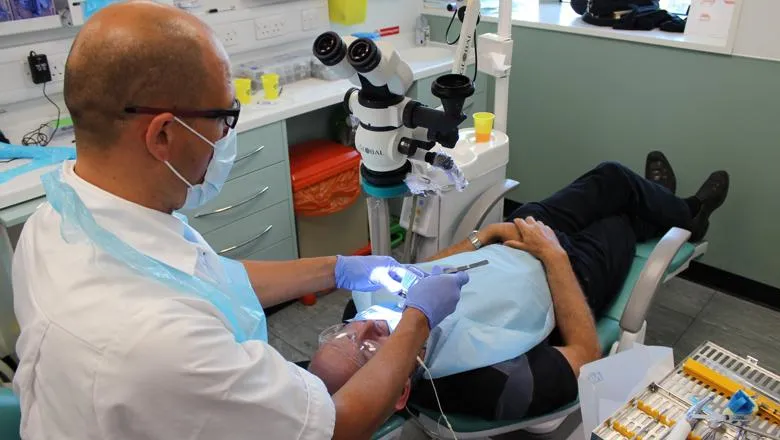08 March 2017
Root canal treatments overhauled through new device to detect untreated bacteria
A new method of detecting bacteria during root canal treatments could eradicate the need for follow up appointments and prevent treatments from failing, according to a study published today in the Journal of Dental Research. The SafeRoot device, created by a team of researchers at King’s College London, enables rapid bacterial detection inside the root canal, ensuring the procedure has been successful and reducing the need for tooth extraction or surgical intervention.

Root canal treatments remove bacterial infections from the root canal space, while retaining as much of the natural tooth as possible. Around a quarter fail over time due to secondary infections, and most procedures require one or two visits to the dentist.
The first appointment is used to remove infected material in the tooth, and to administer an antibacterial treatment. During the second appointment, dentists visually assess the canal to check if the infection has been removed, but this process cannot guarantee that treatment has been successful. Each visit involves drilling and the removal of part of the tooth.
The SafeRoot device was created to detect any existing bacteria once the root canal treatment has been completed, with the aim of eliminating persistent or secondary infections and reducing the need for further treatments. Through florescent dyes and fluorescence microscopy / spectroscopy, SafeRoot can optically detect minute amounts of residual live bacteria in the root canal space. Indeed, during trials the team were able to successfully detect bacterial cells after just three minutes of testing.
Using conventional sterile endodontic paper points which are routinely used in root canal treatments, the process is performed during the treatment, preventing any impact on clinical treatment time and minimising additional clinical steps.
“The resilient nature of bacteria, combined with often complex root canal structures, make disinfection challenging, leading to a considerable number of persistent infections. This is one of the main causes of root canal treatment failures”, explained Professor Francesco Mannocci, Professor of Endodontics from the Dental Institute at King’s College London.
“SafeRoot will reduce the time for root canal completion and will increase the success rate of treatments by letting the dentist know when it’s safe to proceed with filling the tooth. This should produce fewer acute 'flair-ups' and failed root treatments, as any residual infection in the root canal will be identified,” said Professor Tim Watson from the Dental Institute.
One million root canal treatments are conducted under the National Health Service each year, costing the General Dental Service £50.5 million.
“The treatments are not only time consuming and painful for the patients, but cost the NHS a significant amount. If we can reduce the number of root canal treatments and re-treatments required, it could mean sizeable savings to the NHS,” added lead researcher, Dr Frederic Festy from the Dental Institute at King’s College London.
“SafeRoot could be applied to a wide range of biological infections as well, ranging from wound or respiratory, to implant related infections and contaminations.”
Funding for this project was received from the EPSRC CASE Studentship and the Guy’s and St Thomas’ NHS Foundation Trust.
Notes:
The SafeRoot project was chosen by the Design Council to participate in their 2016 Spark Programme, a funding and support programme designed to help entrepreneurs turn their bright ideas into commercially successful products. Over the course of 16 weeks, the research group were provided with specialist expertise and one-to-one mentoring.
The SafeRoot project has been a collaboration between the Biophotonics Research group in the Dental Institute and clinical specialist endodontists in Guy's and St Thomas'.
- Dr. Frederic Festy: Senior Lecturer in Biophotonics
- Prof. Francesco Mannocci: Professor of Endodontics
- Dr Neveen Hosney: Research Associate
- Dylan Herzog: PhD student
- Prof. Tim Watson: Professor of Biomaterials & Restorative Dentistry
- Dr. Federico Foschi: Consultant Endodontist
- Dr. Garrit Koller: Research Associate
- Dr. Richard Cook: Reader in Oral Medicine
Papers mentioned in this news article:
‘Rapid Bacterial Detection During Endodontic Treatment’ by Dylan B. Herzog, Neveen A. Hosny, Sadia A. Niazi, Garrit Koller, Richard J. Cook, Federico Foschi, Timothy F. Watson, Francesco Mannocci, Frederic Festy is published in the Journal of Dental Research at 00.01 GMT on Wednesday 08 March 2017.
Engineering and Physical Sciences Research Council (EPSRC)
As the main funding agency for engineering and physical sciences research, our vision is for the UK to be the best place in the world to Research, Discover and Innovate. By investing £800 million a year in research and postgraduate training, we are building the knowledge and skills base needed to address the scientific and technological challenges facing the nation. Our portfolio covers a vast range of fields from healthcare technologies to structural engineering, manufacturing to mathematics, advanced materials to chemistry. The research we fund has impact across all sectors. It provides a platform for future economic development in the UK and improvements for everyone's health, lifestyle and culture. We work collectively with our partners and other Research Councils on issues of common concern via Research Councils UK.



